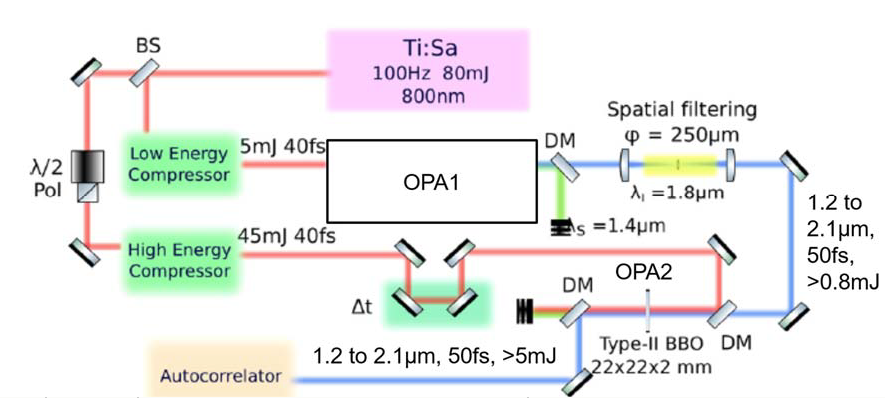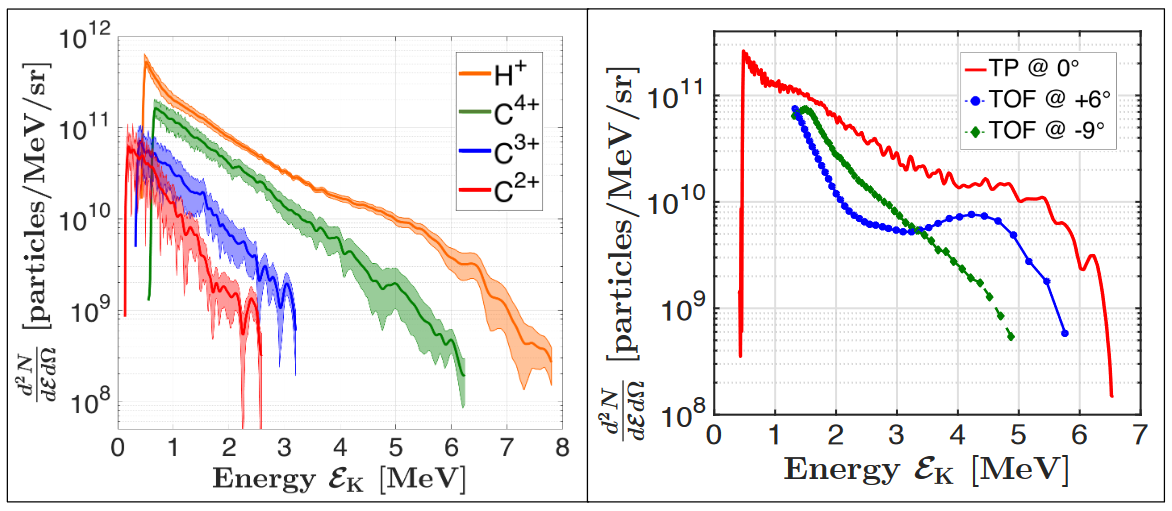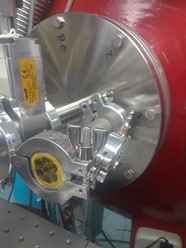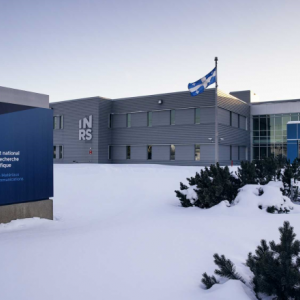Please address
inquiries to:
Email: alls@inrs.ca
Capabilities
Office: 1650, boulevard Lionel Boulet Varennes, QC, J3X 1S2 CANADA
Phone: 514-228-6871
Email: francois.legare@inrs.ca
Read BioThis large national laboratory for laser science is located at the Varennes campus of INRS-EMT (20 minutes to the North-East of Montreal). Opened to users since 2005, the facility was financed through the "International Joint Ventures Fund" program of the Canada Foundation for Innovation (CFI) with an initial investment of $20.95M, enabling the development of ultrafast light sources for revolutionary applications.
Subsequently, this laboratory achieved the development of a large variety of laser light sources reaching from THz (300 µm wavelength) to hard X-rays (Angstrom – 0.1 nm wavelength) providing ultra short pulse durations. Since these light sources are generated in an all-optical way, light pulses of different wavelengths can be spatially and temporally synchronized. This opens the door to explore the potential of dynamic imaging of atomic, molecular and condensed matter systems and provides the unique tools to explore the fundamental questions of physics and chemistry. This leads to important outcome in fundamental science as well as in innovative technological applications and tools. Among them are medical high resolution imaging for mammography and particle acceleration for future proton therapy, micro machining and material processing, as well as applications for security and defense, telecommunication and information.
The facility currently hosts 3 beam-lines:
The persons in charge of the facility can be contacted at alls@inrs.ca.
This infrared beam‐line is derived from a commercial 100 Hz CPA Ti:Sa laser system delivering 800 nm ultrashort pulses with 40 fs pulse duration after compression with a repetition rate of 100 Hz. Two independent compressors are available at the output. A low energy compressor is delivering up to 5 mJ to pump OPA1. This OPA delivers tunable infrared pulses at mJ level. Then, this OPA output is spatially filtered and seeds a following high‐energy 22x22 mm OPA stage (OPA2). To pump this stage, the high energy compressor of the laser system delivers up to 45 mJ at 800 nm. The beams can be coupled to either one of the two fixed hollow‐core fibers to achieve pulse compression down to few‐cycle regime, or to generate mid‐infrared pulses tunable from 3 to 12 microns (energy range from 10 to 100 µJ).

| Wavelength (nm) |
Pulse duration (fs) |
Energy per pulse (mJ) | |||
|---|---|---|---|---|---|
| Compressor 1 | 800 | 40 | 5 | ||
| Compressor 2 | 800 | 40 | 45 | ||
| OPA 1 | 1200-2100 | 50 | 0.8 | ||
| OPA 2 | 1200-2100 | 50 | 5 | ||
| Fiber | 800, 1400, 1800 | 7-15 | 0.5-3 | ||
| Mid-infrared | 3000 to 12000 | sub-150 | 0.01-0.1 | ||
The measured typical X‐ray source parameters are as follows: 3x109 photons/0.1% bandwidth/sr/shot at 20 keV, a critical energy between 20 and 30 keV, an effective X‐ray source size of 1.5 μm, a divergence that can be controlled between 10 and 50 mrads (FWHM), an X‐ray beam pointing stability and an X‐ray energy stability in the few% rms range. The beamline runs at 2.5 Hz with a typical 20 μJ energy (giving 50 μW) in the 30keV‐ 40keV band. Phase contrast imaging can be realized in the in‐line geometry and a standard transmission geometry with a divergent beam is used. The object to be imaged is positioned between the X‐ray source and the detection system. R1 and R2 were respectively the source to object and the object to detector distances. The magnification M was thus given by M=(R1+R2)/R1. R2 is limited by the laboratory space to a maximum value of 300cm. Many calibrations objects including a series of nylon fibers placed with diameter ranging from 10μm to 400μm are available.
The X‐ray source is driven by the 2.5 Hz high‐peak power laser system of ALLS: Laser parameters on target can be varied in the range of 80 TW and 220 TW peak power, with laser energy in the range between 1 J and 4 J at pulse durations in the range of 18 fs to 35 fs. The laser beam is focused in a gas jet (nozzle with length varied between 3 mm and 10 mm) with an off‐axis parabola (1.5 m focal length) in a spot (central spot) diameter around 15 μm. The laser intensity, I_L, on target, can be varied between 5x1018 W/cm2 and 5x1019 W/cm2 giving a field amplitude, a0 between 1.5 and 5. The gas jet electron density, n, can be adjusted between 1018 cm‐3 and 1019 cm‐3 in order to explore a range of ratio P/Pc between 4 and 80, where Pc is the critical power (Pc = 17 (nc/n) [GW]).
Diagnostics include phase front and pulse duration for the laser pulse (at full energy), the far‐ field and near field, the optical spectrum, time‐resolved transverse shadowgraphy (15 μm and 50 fs resolutions), Thomson scattering, electron spectrum (100 MeV – 1 GeV), and several X‐ray CCD cameras.
The ion acceleration beam-line is currently based on laser-irradiation of solid micrometric targets, implementing the most routinely existing rear-target surface acceleration mechanism (so-called Target Normal Sheath Acceleration).
The target chamber allows for single and multiple target shooting. The multiple target holder can currently fit about 400 targets that can be shot automatically at a maximum repetition rate of about 0.625 Hz. Maximum shot rate is about 400 shots per pumping cycle – enabling more than 2000 shots per day. . Targets and multi-target holder are pre-aligned using a target alignment bench before being put in the Target Chamber Center, where they are shot using an f/3 parabola focusing down to an intensity of 2 x 1020 W/cm2. A proton energy selector from 0.5 to 10 MeV with adjustable bandwidth is now available to users.

As proton detectors we have installed a Thomson Parabola using an MCP (at 0° from the proton axis). On the proton axis we have installed a mini-chamber that allows performing experiment interacting with the protons, e.g. for laser-PIXE experiments. There is the option to use the protons In-Air over a vacuum-to-air interface using a Kapton 7.5 µm window and 7 holes of diameter 7 mm.

| Parameter | Value |
|---|---|
| Center Wavelength | 800 nm |
| Pulse duration (I FWHM) | 22 fs |
| Max energy on target | 3.2 J |
| Shot energy stability | 1.22% rms |
| F/number @ target | 15 (LWFA) / 3 (ion beam-line) |
| Focal spot diameter (FWHM) | 15 µm (LWFA) / 5 µm (ion beam-line) |
| Strehl ratio @ target | >0.9 with deformable mirror |
| Energy containment @ target | 80% within 1/e2 radius |
| Pointing stability | 5 µrad |
| Picosecond pre-pulse contrast | 8x10-9 |
| Nanosecond pre-pulse contrast | 10-9 |
| Laser repetition rate | 2.5 Hz |
Contacts
Please address
inquiries to:
Email: alls@inrs.ca
News, Events & Publications

